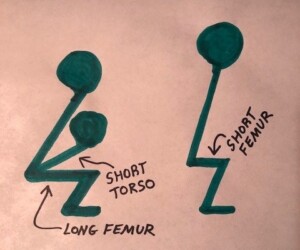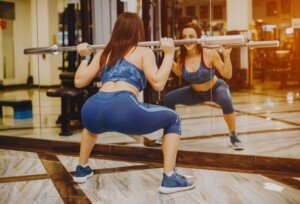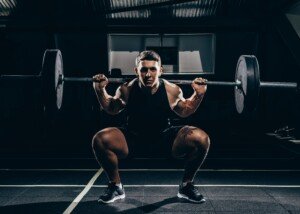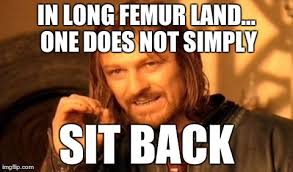
Why is it that some women find back squats easy while others struggle?
Some women take to this exercise fairly quickly and are just a natural at it.
Then there are those—perhaps you yourself—who just can’t seem to “get it…” even though you have solid knees, no back pain issues, etc.
This article pertains to the back squat—barbell across the back. If you’d like to do this, see first how you do with a bodyweight squat.
Many women will easily be able to drop to past parallel and feel comfortable, while others will struggle, feeling as though they will fall backwards even before they hit parallel (thighs parallel to floor).
This latter group will also find that their back has a tendency to round, while the “naturals” will be able to keep a small arch in their lower back (the correct form).
The key difference between these two groups is body proportions.
To prevent falling backwards your shoulder needs to be directly overhead the midfoot, forming a vertical line from shoulder to midfoot.
The Chair Test for Squat Body Proportions
• Sit on edge of chair that permits thighs to be parallel to floor.
• Keep feet flat on floor, wider than shoulder width, side by side.
• Move feet towards chair, keeping them flat on chair, as far as possible before you feel that you must elevate your heels.
• Keeping your back straight, arch in the lumbar area, lean forward so as to align shoulders smack overhead of the midfoot. No back rounding!
• How far must you lean forward to achieve the vertical alignment? This is how far you’d have to lean forward if doing a back squat with a barbell.
You may not have to lean that much forward (lucky) while others will have to pitch way forward (lousy proportions or “levers”).
Many women’s torsos are short, relative to femur (thigh bone), making them high waisted. What jumps out at me, in the image below of the woman on a treadmill, is how short her torso is, relative to hip-to-feet length and overall body height.

She’d probably have to lean way forward to get her shoulder above the midfoot in a back squat, though this can be somewhat offset by a relatively long shin bone.
But generally, short torso + long femur bone (regardless of overall body height) = poor proportions for back squats.
If the torso is shorter than femur length, you can see why a big forward lean is required to get the shoulders over that midfoot.
If shoulder falls short of vertical line in an actual back squat, you’ll fall backwards. It’s Physics 101, no way around it.
But a torso longer than the femurs?
You won’t need to lean so far forward to align the shoulder over the midfoot, allowing you to sink straight down into a deep squat without folding in half.
These various body proportions are independent of overall body height. A very tall woman can have short femurs and a long torso.
A very short woman can be quite high waisted. I’ve seen tall women with crazy long SHINS, which helps offset a relatively short waist, allowing them to comfortably do squats with good form.
If you have bad squat proportions, you can still work around these by developing lower back flexibility, ankle flexability and adopting a wider stance with feet slightly pointing out.

If you’re struggling with squats, widen your stance to double shoulder width and see how it goes. Freepik.com
You can also do other forms of squats (kettlebells held at the shoulders or at the sides, plate held to your chest, etc.).









































